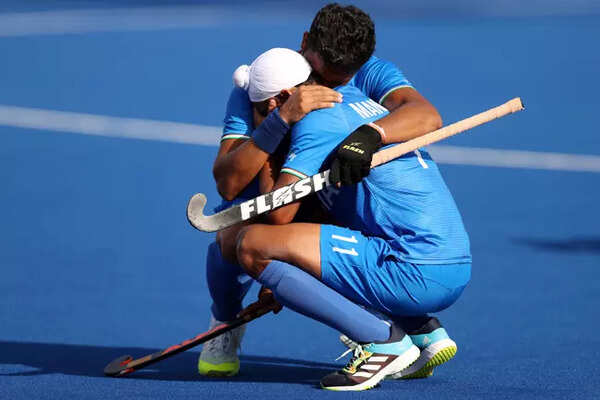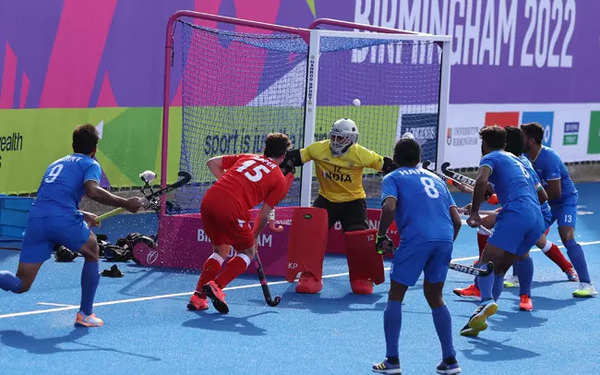CWG 2022 Hockey: From scintillating to sorry, India’s story of two halves vs England | Commonwealth Games 2022 News – Times of India
The home crowd bobbed anytime an English stick tapped the ball forward. But for most part of the first two quarters, those taps followed odd retrieves after an Indian attack.
The Indian supporters, outnumbered and out-cheered in the stands by their English counterparts, sat still for a change — numbed by a sense of nostalgia unfolding on the pitch.
If Harmanpreet’s odd run and body dodge in England‘s half reminded hockey fans of Pargat Singh, Nilakanta’s pass to cut the defence in half brought back memories of Prabhjot. And Mandeep’s finishing touch completed that famous trio of the past, with Gagan Ajit Singh and Deepak Thakur rolled into one.
Three goals in the first 22 minutes was a harsh lesson for England to stomach. This, after all, was the ‘match of Pool B’ — expected to decide who finishes on top and faces the No. 2 team in Pool A in the semis. But this script certainly wasn’t what both India and England would have had in mind before the game began.
Modern hockey is a strange game, and can change within seconds. This one did, too.
Despite leading 4-1, India were held to a 4-4 draw by the English.
Points shared at the full-time! On to the next one ????IND 4:4 ENG #IndiaKaGame #HockeyIndia #B2022… https://t.co/3HT55a9XGD
— Hockey India (@TheHockeyIndia) 1659371974000
Taking nothing away from England’s comeback, the manner in which the game turned on its head and the reasons behind it is what top players in top teams always strive to ensure they avoid.
DECODING ENGLAND’S COMEBACK
When Mandeep scored his second goal in the 22nd minute, India were playing with 10 men. Defender Varun Kumar had been shown a yellow card in the 19th minute for a five-minute suspension. But India held firm, Varun returned to the pitch and at half-time, down 0-3, England were staring at a mauling.
But what that one-man advantage for five minutes before the half-time hooter did was that it allowed England to regroup and find some momentum. They had three shots at the Indian post between the 20th and the 30th minutes. It laid the foundation of their first goal in the 42nd minute through Liam Ansell. And before the third quarter ended, Varun was penalised for his second offence with another yellow card.
This time the suspension was for 10 minutes.
Indian men ????team started well & looked really good against #England but towards the later quarter lost focus & cont… https://t.co/yNQY0Q5XEb
— Jagbir Singh OLY (@jagbirolympian) 1659416756000
Playing against the run of play, India managed to restore their three-goal lead when Harmanpreet’s drag-flick off a penalty corner made it 4-1. But Nicholas Bandurak (47th minute) and Phillip Roper (50th) brought England within a goal from equalising. It was 4-3 at that stage.
Roper’s goal, in fact, showed that the situation and being down one man played heavily on the Indian players’ minds. The England striker’s overlapping run from the left of the Indian circle ended in him pushing the ball past goalkeeper PR Sreejesh on the near post from a zero angle. That doesn’t happen often.
But the ‘card’ game didn’t end there. Gurjant Singh was yellow-carded as well — a raised stick deemed too dangerous by the umpire, who penalised the Indian striker with a 10-minute suspension instead of the usual five for a yellow card. India were down to nine players for three minutes in the fourth quarter, after which Varun returned from his second suspension to make it 10 players on the field.
But for the time India had nine players on the pitch, in the 53rd minute, Bandurak slotted home his second goal and the equaliser to send the home fans into raptures.
A game that looked to be firmly in India’s grasp ended with them splitting points with England. However, with a game in hand compared to England, captain Manpreet Singh’s team may still finish on top of Pool B.

(Getty Images)
But this game must undergo a serious postmortem by the Indian think-tank. The indiscipline that led to the yellow cards needs to be addressed by coach Graham Reid, and then playing the situation rather than the ball is where India was found out in the final quarter. However, it’s beyond any doubt that to defend with nine players against 11 in modern hockey is a very tough task.
“The only reason why the match ended in a 4-4 draw when we were up 4-1 in the fourth quarter is that we totally lost our discipline with two yellow cards and were down to nine men for majority of the fourth quarter, not because we played badly,” former India captain Viren Rasquinha wrote on twitter.
Rasquinha, who heads Olympic Gold Quest, went on to highlight the fact how players not being sanctioned for a punishable offence in the domestic circuit leads to bad habits when they turn international.
“Whether the two yellow cards warranted 10-minutes suspension each (for Varun and Gurjant) or not is debatable, but they were both 100% yellow cards. Just because umpires do not penalise dangerously-raised sticks in domestic hockey does not mean our players will get away with the same thing in international hockey.
“When referees don’t whistle such fouls in domestic hockey, it leads to bad habits for which India gets punished. Imagine if this same situation had to happen in the fourth quarter of an Olympic final. A big part of discipline in hockey is concentration. Cannot afford silly fouls that hurt the team, ” Rasquinha, a junior World Cup winner and an Asain Games silver medallist, opined in another tweet.

(Reuters Photo)
In simple terms, India went from scintillating to sorry in a story of two halves on Monday.
The Indian men will now play back to back matches on Wednesday and Thursday against Canada and Wales respectively, and a much more disciplined effort will be expected from the team, who had to return medal-less from the last edition of the CWG in 2018, after losing the bronze medal match to England 2-1.
For all the latest Sports News Click Here

